Measured Parameters of Meteorology
Meteorological measurements for weather forecasting and climatology have been carried out on a regular basis for centuries. However, the data acquired can only be evaluated and interpreted after having statistically recorded medium-term and long-term atmospheric conditions.
Nowadays, transport and communications such as ground, air and sea traffic could not be maintained without these data, which are mainly being collected from measurements and observations in the atmosphere close to the ground (the Boundary Layer). The main meteorological parameters in this field are:
· Wind speed and direction
· Air temperature
· Air pressure
· Air humidity
· Precipitation
· Haze and contents of the air
· Solar and terrestrial radiation
These parameters are also significant for such issues as air pollution, avalanche warning, sun simulation, renewable energy industry, agriculture, forestry, water supply and distribution, town and regional planning. For example, the evaluation and interpretation of gas emission measurements is only possible in comparison with meteorological data acquired concurrently.
The structure of the atmosphere close to the ground is extremely important for the local climate. Knowing the solar radiation as well as the air humidity and air temperature is necessary to evaluate chemical reactions of pollutants in the air.
All meteorological parameters are subject to short-term variations, normally caused by turbulences within the atmosphere. All meteorological parameters are influenced by solar radiation, directly or indirectly, and this results in typical daily or yearly trends.
In order to be able to evaluate these typical trends it is necessary to compute the mean values from the actual ones measured over a specific period. For some meteorological parameters it is quite easy to understand their daily cycle. For example, the temperature cycle is normally a simple curve with a minimum value shortly after sunrise and a maximum in the early afternoon. The yearly cycle of a meteorological parameter can be determined by making daily measurements. The average yearly cycle within a climatic region is normally determined by making measurements over a minimum of 30 years.
Of course, meteorological measurements have to be made outside. This means that the sensors and associated electronics must be designed to withstand the local climatic conditions, which may be extreme, from deserts to Antarctica.
Within the atmosphere close to the ground the temporal and spatial characteristics of radiation values are influenced by the characteristics of the ground surface. The most influential factors affecting the received radiation at any particular location are:
· Location on the earth
· Date and time
· Precipitation (cloud, fog, rain, snow)
· Constriction of the horizon (field of view)
· Air pollution (aerosols and gasses)
· Albedo
Due to the physical effects mentioned above it is sometimes not sufficient for many application fields to just measure the ‘Global Radiation’ coming from all around the measurement location. It may also be necessary to measure the ‘Direct Radiation’ coming only from the sun and/or the ‘Diffuse Radiation’ (not coming directly from the sun). The ‘Radiation Balance’ of incoming to outgoing radiation in the short-wave and long-wave may also be required.
Before reaching the ground the solar radiation is influenced by our atmosphere and its physical characteristics and an essential parameter is the absorption in different wavelength ranges. Albedo is affected by surfaces with different reflection characteristics, such as water, ice, snow, stone, grass, crops or woodland.
The different wavelength ranges as well as the properties of the atmosphere and the ground surface must be taken into consideration and this makes it necessary to develop special sensors suitable for individual, very complex, measuring tasks.
In order to be able to develop the proper sensor, it is necessary beforehand to determine which meteorological value shall be measured and how it is defined.
The parameters within the short-wave spectral range are:
| Direct Solar Radiation |
S |
| Diffuse Sky Radiation |
H |
| Global Radiation |
G (= S + H) |
| Reflected Global Radiation |
R |
| Albedo (Reflection Factor) |
R / (S + H) |
| Short-wave Radiation Balance |
(S + H) - R |
The parameters within the long-wave spectral range are:
| Atmospheric Radiation |
A |
Emission of Ground Surface
(including reflected atmospheric radiation) |
E |
| Downward Global Radiation |
S + H + A |
| Upward Global Radiation |
R + E |
| Long-wave Radiation Balance |
A - E |
Consequently, the radiation balance over the complete spectrum is the difference between received and returned radiation:
Radiation Balance Q (= S + H – R + A - E)
These parameters represent the most important climatological factors, for which the following sensors have been developed.
Direct Solar Radiation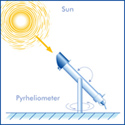
| Sensor |
Pyrheliometer |
| Spectral Range |
300nm - 3,000nm |
| View Angle |
< 5º |
| Neccessary Accessory |
Sun Tracker |
Global Radiation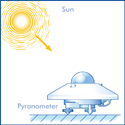
| Sensor |
Pyranometer |
| Spectral Range |
300nm – 3,000nm |
| View Angle |
180° |
| Necessary Accessory |
None |
Reflected Global Radiation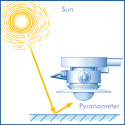
| Sensor |
Pyranometer |
| Spectral Range |
300nm – 3,000nm |
| View Angle |
180° |
| Necessary Accessory |
Glare Shield to keep out
low-angle non-reflected
radiation |
Diffuse Sky Radiation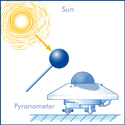
| Sensor |
Pyranometer |
| Spectral Range |
300nm – 3,000nm |
| View Angle |
180° |
Necessary Accessory:
Shading Device: |
Shadow Ring
Shadow Band
SunTracker/Shadow Ball
Sun Tracker/Shadow Disk |
Atmospheric Radiation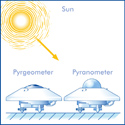
| Sensors |
Pyranometer and Pyrgeometer |
| Spectral Range |
300nm – 50µm |
| View Angle |
180° |
| Necessary Accessory |
None |
Emission of Ground Surface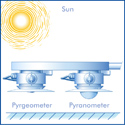
| Sensor |
Pyranometer and Pyrgeometer |
| Spectral Range |
300nm – 5oµm |
| View Angle |
180° |
| Necessary Accessory |
Glare Shields to keep out
low-angle non-reflected
radiation |
Radiation Balance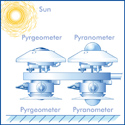
| Sensor |
Net Radiometer
2 Pyranometers and
2 Pyrgeometers |
| Spectral Range |
300nm – 50µm |
| View Angle |
180° |
| Necessary Accessory |
Glare Shields for downward
facing sensors to keep out low-
angle non-reflected radiation |
Combinations of these meteorological measurements are necessary for weather forecasts, climatology and other applications mentioned before, depending on the task and the accuracy required.
In order to monitor and minimise air pollution, measurements complying with the requirements of national standards for the evaluation of emissions and air quality are also made. These are termed ‘environmental measurements’.
Usually these environmental measurements comprise the measurement of the global radiation, the direct radiation and the radiation balance. The data acquired from global radiation and direct radiation, together with specific spectral data help to determine the amount of gasses and aerosol particles in the air and also provide information on the photo-chemical formation of secondary impurities. Measuring the radiation balance provides information on the vertical exchange and spread of the pollution.
A further field of application for solar sensors is environmental simulation where the effect on materials is tested under ‘artificial suns’. In order to cut down the testing time, very high intensity artificial radiation sources are used that far exceed the maximum natural value of 1,367 W/m² (the Solar Constant). Sensors that are used for these purposes should have measuring ranges that allow for radiation levels in the range 2,000 to 4,000 W/m² and they are often required to work at high temperatures (> 100ºC).
Source: Solar Radiation Measurement by Reinhold Rösemann